Related Research Articles

The usher of the Black Rod is an official in the parliaments of several countries of the Commonwealth of Nations. The title is often shortened to Black Rod, and in some countries, formally known as Gentleman Usher of the Black Rod if male, or Lady Usher of the Black Rod if female. The position originates in the House of Lords in the Parliament of the United Kingdom. Equivalent positions also exist in Australia, Canada and New Zealand.
The Scottish Episcopal Church is the ecclesiastical province of the Anglican Communion in Scotland.

The Cathedral of the Blessed Virgin Mary is a Church of England cathedral in the city of Truro, Cornwall. It was built between 1880 and 1910 to a Gothic Revival design by John Loughborough Pearson on the site of the parish church of St Mary. It is one of only three cathedrals in the United Kingdom featuring three spires.

Dunblane is a town in the council area of Stirling in central Scotland, and inside the historic boundaries of the county of Perthshire. It is a commuter town, with many residents making use of good transport links to much of the Central Belt, including Glasgow and Edinburgh.

The Honours of Scotland, informally known as the Scottish Crown Jewels, are the regalia that were worn by Scottish monarchs at their coronation. Kept in the Crown Room in Edinburgh Castle, they date from the 15th and 16th centuries, and are the oldest surviving set of crown jewels in the British Isles.

St Giles' Cathedral, or the High Kirk of Edinburgh, is a parish church of the Church of Scotland in the Old Town of Edinburgh. The current building was begun in the 14th century and extended until the early 16th century; significant alterations were undertaken in the 19th and 20th centuries, including the addition of the Thistle Chapel. St Giles' is closely associated with many events and figures in Scottish history, including John Knox, who served as the church's minister after the Scottish Reformation.
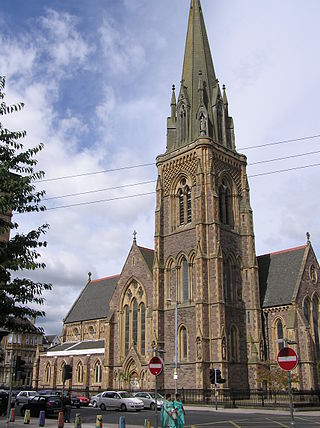
The Cathedral Church of St Mary the Virgin, commonly called St Mary's Cathedral, is a cathedral of the Scottish Episcopal Church. It is located on the Great Western Road, in the west end of Glasgow, Scotland. The current building was opened on 9 November 1871 as St Mary's Episcopal Church and was completed in 1893 when the spire was completed. The architect was Sir Gilbert Scott. It was raised to cathedral status in 1908. The total height of the cathedral is 63 metres. The church structure is protected as a category A listed building.

Edward Bannerman Ramsay,, usually referred to as Dean Ramsay, was a clergyman of the Scottish Episcopal Church, and Dean of Edinburgh in that communion from 1841, has a place in literature through his Reminiscences of Scottish Life and Character, which had gone through 22 editions at his death. It is a book full of the personality of the author, and preserves many traits and anecdotes.
The Bishop of Edinburgh, or sometimes the Lord Bishop of Edinburgh, is the ordinary of the Scottish Episcopal Diocese of Edinburgh.
Gentleman Usher and Lady Usher are titles for some officers of the Royal Household of the United Kingdom. For a list of office-holders from the Restoration of the monarchy in 1660 up to the present day see List of Lady and Gentleman Ushers.

The Cathedral Church of Saint Mary the Virgin, commonly known as St Mary's Episcopal Cathedral, is a cathedral of the Scottish Episcopal Church in the West End of Edinburgh, Scotland; part of the worldwide Anglican Communion.
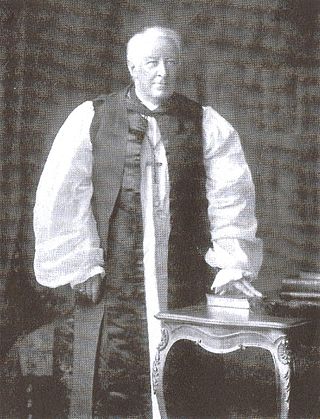
John Dowden /d͡ʒɒn ˈdaʊdən/ was an Irish-born bishop and ecclesiastical historian. He served in the Scottish Episcopal Church as the Bishop of Edinburgh.

St Mary's Music School is a music school in Scotland in the West End of Edinburgh, for children aged 9 to 19 and is also the Choir School of St Mary's Episcopal Cathedral. The school, which is non-denominational, provides education for children with a special talent in music, and is Scotland's only full-time independent specialist music school. In 2023 the school has 64 pupils from many different backgrounds and from all parts of Scotland, the rest of the UK and abroad –

The Diocese of Edinburgh is one of the seven dioceses of the Scottish Episcopal Church. It covers the City of Edinburgh, the Lothians, the Borders and Falkirk. The diocesan centre is St Mary's Cathedral, Edinburgh. The Bishop of Edinburgh is the Right Revd Dr John Armes.
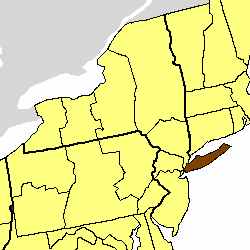
The Episcopal Diocese of Long Island is the diocese of the Episcopal Church in the United States of America with jurisdiction over the counties of Kings, Queens, Nassau and Suffolk, which comprise Long Island, New York. It is in Province 2 and its cathedral, the Cathedral of the Incarnation, is located in Garden City, as are its diocesan offices.
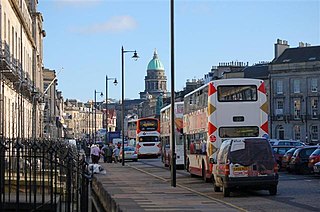
The West End is an affluent district of Edinburgh, Scotland, which along with the rest of the New Town and Old Town forms central Edinburgh, and Edinburgh's UNESCO World Heritage Site. The area boasts several of the city's hotels, restaurants, independent shops, offices and arts venues, including the Edinburgh Filmhouse, Edinburgh International Conference Centre and the Caledonian Hotel. The area also hosts art festivals and crafts fairs.
The White Rod, White Wand, Rod of Inauguration, or Wand of Sovereignty, in the Irish language variously called the slat na ríghe and slat tighearnais, was the primary symbol of a Gaelic king or lord's legitimate authority and the principal prop used in his inauguration ceremony. First documented in the 12th century Life of Máedóc of Ferns, but assumed to have been used long before then, it is last documented in Ireland in the early 17th century. In Scotland the rod was used into the 13th century for the inauguration of its last Gaelic-speaking kings, and for the Norse-Gaelic Lords of the Isles into the 15th.
Ian Gregory Bishop is a British Anglican bishop. Since September 2023, he has been Bishop of Thetford, a suffragan bishop in the Church of England's Diocese of Norwich. He was Archdeacon of Macclesfield in the Diocese of Chester from 2011 to 2023.
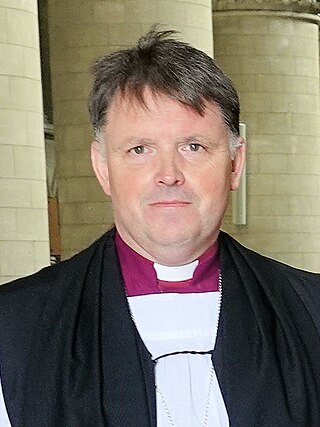
Graham Barham Usher is an Anglican bishop and ecologist. Since 2019, he has been the Bishop of Norwich; he had previously served as Bishop of Dudley, a suffragan bishop in the Diocese of Worcester.

James Buchanan (1785–1857) was a Scottish businessman and philanthropist who established the Buchanan Institute in Glasgow. He was a partner in Dennistoun, Buchanan & Co. of 36 Candleriggs. His endowment creation of the Buchanan Ewing Bequest still funds education of Scottish youth.
References
- 1 2 3 4 5 6 "The Walker Trust Act, 1877" (PDF). UK Parliament. Archived (PDF) from the original on 14 April 2023. Retrieved 14 April 2023.
- 1 2 "The Usher of the White Rod". The Scottish Antiquary, or, Northern Notes and Queries. 11 (44): 158–170. 1897. ISSN 2042-0013. JSTOR 45256227. Archived from the original on 2023-04-14. Retrieved 2023-04-14.
- ↑ "Society's History". Imperial Society of Knights Bachelor. Archived from the original on 6 April 2023. Retrieved 14 April 2023.
- ↑ "Walker Trustees V. Lord Advocate and Others". Case Mine. Archived from the original on 14 April 2023. Retrieved 14 April 2023.
- ↑ The Scottish Antiquary Volume XVI. Edinburgh: Office of Electronic Information Dissemination Services. 1902.
- ↑ "People who will play historic roles at the heart of the Coronation Service announced". Cabinet Office. Archived from the original on 10 April 2023. Retrieved 14 April 2023.
- 1 2 "The Walker Trust Annual Report and Accounts Year ended 31 December 2021" (PDF). Scottish Charity Regulator. Archived (PDF) from the original on 14 April 2023. Retrieved 14 April 2023.